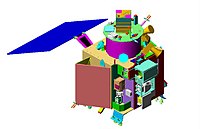
Photo from wikipedia
Abstract. The Snow and Water Imaging Spectrometer (SWIS) is a science-grade imaging spectrometer designed for CubeSat integration, spanning a 350- to 1700-nm spectral range with 5.7-nm sampling, a 10-degree field-of-view,… Click to show full abstract
Abstract. The Snow and Water Imaging Spectrometer (SWIS) is a science-grade imaging spectrometer designed for CubeSat integration, spanning a 350- to 1700-nm spectral range with 5.7-nm sampling, a 10-degree field-of-view, and 0.3-mrad spatial resolution. The system operates at F / 1.8, providing the high throughput for low-reflectivity (<1 % ) water surfaces, while avoiding saturation over bright snow or clouds. The SWIS design utilizes heritage from previously demonstrated instruments on airborne platforms while advancing the state of the art in compact sensors of this kind in terms of size and spectral coverage. Compared with airborne campaigns, the CubeSat platform allows for more frequent and regular sampling, while maintaining intermediate to high resolution relative to heritage global sensors. Through frequent repeat observations from space at a moderate spatial resolution, SWIS can address key science questions concerning aquatic and terrestrial ecosystem changes, cryosphere warming and melt behavior, cloud and atmospheric science, and potential impacts of climate change and human activities on the environment.
Journal Title: Journal of Applied Remote Sensing
Year Published: 2018
Link to full text (if available)
Share on Social Media: Sign Up to like & get
recommendations!